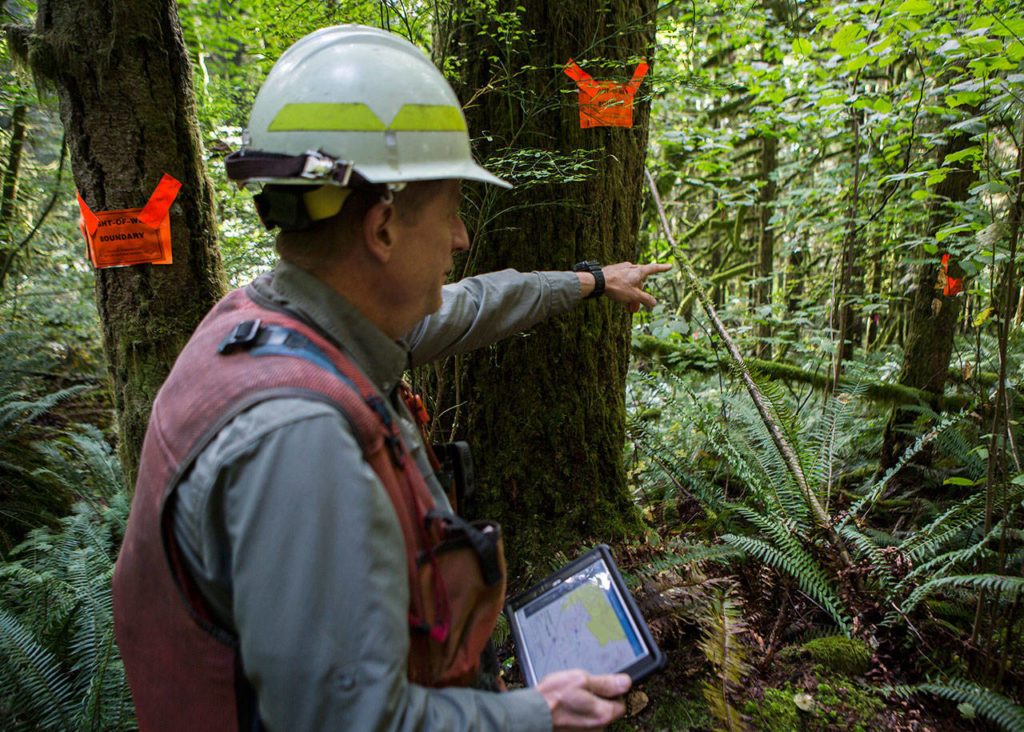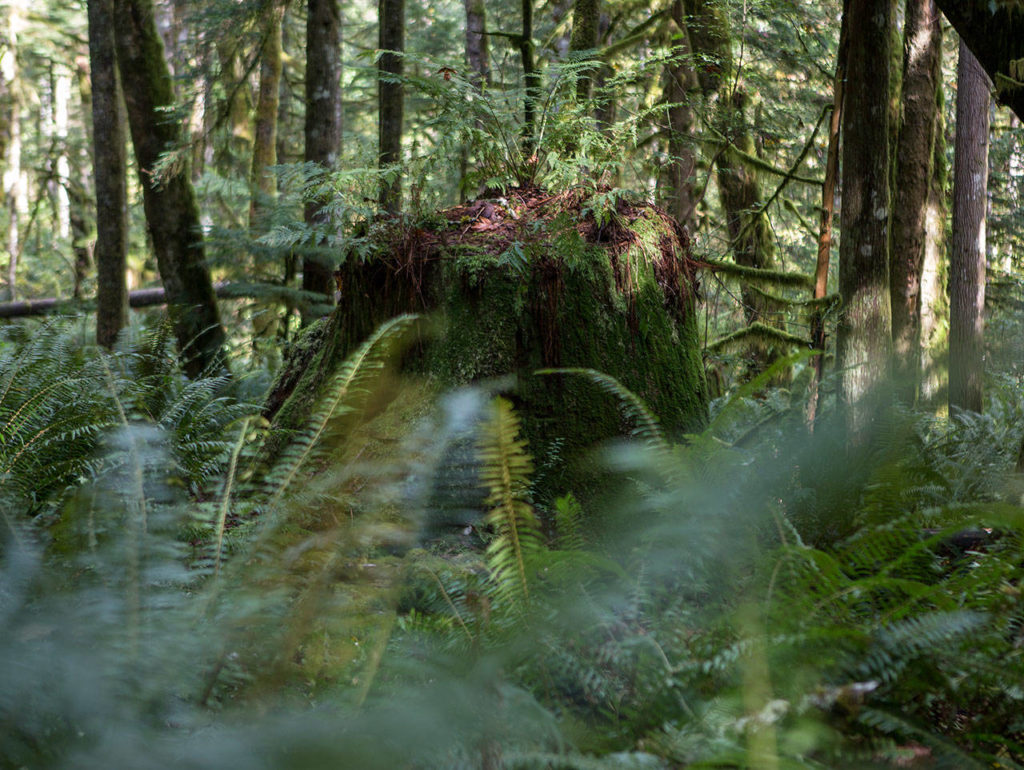GOLD BAR — They veered from the marked trail to trudge over a thick carpet of trailing blackberries and Oregon grape.
A slippery trek well into the brush last week brought the state foresters and their colleagues to orange-tagged trees where logging roads could get built — “could” being the operative word.
These lichen-draped woods next to Wallace Falls State Park live on contested ground. The Department of Natural Resources has sought to harvest them for more than a decade. Profits would flow to the Sultan School District, library and other local governments.
The state did auction off the timber two years ago, only to have a judge void the sale.
Since then, staff from the state agency have tried to walk a narrow path between timber companies and local governments, who have an interest in seeing the trees fall, and environmentalists and their allies, who don’t.
“This has had a lot of public outreach through meetings, workshops — for years,” said Al McGuire, a district manager for the DNR’s Northwest Region.
What used to be known as the Singletary harvest, DNR has rebranded as the Middle May timber sale, after nearby May Creek. It would cover about 180 acres broken up in five separate pieces. State foresters hope to see it go to auction next spring.
The land in question makes up a small part of the 10,000-acre Reiter Foothills State Forest. It’s situated in the half of Reiter set aside for non-motorized activities, such as hiking, mountain-biking and horseback riding. Other parts of Reiter are designated for off-road vehicles, motorcycles and quads.
Longtime Singletary critics aren’t impressed with the new plan. They call it “Son of Singletary.” They concede it’s better, but say it remains fatally flawed. They continue to disagree with the DNR on just about everything.
“If we don’t want this to look like an industrial logging operation, there are numerous alternatives to a clearcut,” said Peter Goldman from the Washington Forest Law Center. “But DNR has said we are not going to do anything different.”
Though similar in size, the contours of the new sale have changed. Middle May’s western edge comes right up to the state park border, as did Singletary. The eastern areas of the proposed harvest, however, are farther apart. A central area is set aside as spotted owl habitat.
“They basically took the same sale and spread it out,” Goldman said. “It’s basically like stepping in a puddle and spreading it all out.”
State foresters said Goldman’s characterization isn’t accurate.
McGuire has worked in the area long enough that he’s thinned maturing forests he planted in the 1990s. Before his retirement, he hopes to see through final harvests in those same areas.
“Pretty typical 60- to 80-year-old timber stand,” he observed as he hiked through the proposed Middle May sale outside of Gold Bar. “Naturally regenerated after logging and fire.”
Science isn’t the only way to guess the forest’s age.
“Another way to age the stand is that they used railroad logging, which was primarily before World War II,” McGuire said. “After World War II, they had a lot of cheap trucks — they were all green too.”
The fallen Douglas fir and western hemlocks are expected to fetch $1.7 million worth of profit, for school, library and hospital districts, as well as fire protection and road maintenance. A final appraisal is expected early next year. The land belongs to Snohomish County, but is managed in trust by the state with a mandate to generate timber revenue, along with recreation and habitat goals.
County Councilman Sam Low is eager to see the sale go ahead.
“We’re finally moving this forward for the junior taxing districts,” said Low, whose council district covers eastern Snohomish County. “This funds so many things — schools and county roads. That hasn’t gotten the attention it deserves … DNR’s No. 1 responsibility is to manage these trust lands for the junior taxing districts.”
Mike Town, a retired science teacher who formerly lived in Sultan, is sensitive to the needs of schools and other junior taxing districts. He thinks there are other ways to make them whole, and opposes the state’s approach to harvesting land next to Wallace Falls.
“We’re concerned,” Town said. “Originally, the DNR had suggested that this whole area next to the park would be spotted owl habitat. Now it would be a variable retention harvest — call it what you will, it’s clear-cutting.”
DNR staff object to calling it a clear cut. Their plans to log Middle May would leave a minimum of eight trees standing per acre, and many more around streams, wetlands or other critical habitat.
A flash point is how timber cutting in the area would affect access trails and an alternative trailhead on the east side of Wallace Falls State Park, a destination so popular, it’s often impossible to find parking.
Town and his allies see the Middle May area as a potential solution. Snohomish County already owns an adjoining property with an informal trailhead. It leads to trails in the direction of Wallace Falls, but doesn’t yet connect into the state park. If those trails on the east side of the Wallace River are built out, the county property could serve as an alternative trailhead to the state park’s overcrowded lot off Ley Road.
“This area, an area adjacent to Wallace Falls State Park, should be studied by the public, with public input, with a view to what areas could be used to expand the state park, with a mechanism that could be used to provide benefits to the beneficiaries,” Town said. “In the meantime, they’re going to put six miles of road right through the heart of the trail system (that exists on the DNR land).”
The DNR has rejected three alternatives suggested by the logging opponents. One would involve Snohomish County taking back control of the property through a process known as reconveyance, with an accompanying effort to raise money for the school district and other local governments to compensate for the missing timber revenue. A second would have the Legislature put the area into public ownership through the Trust Land Transfer Program. A third would allow logging through more environmentally sensitive techniques.
Under the DNR’s new forestry plan, almost a mile of trail would be relocated because of the harvest. Other trails would remain, but would close during logging activities.
The DNR hopes to see the harvest go through the permitting process early next year, then reach the state Board of Natural Resources in April. If approved, the harvest would go to auction in May and start in June. Operations could last three years or more.
The area will be replanted with a mix of Douglas fir and western red cedar.
A key component would be building a $1.5 million road system, including four bridges, to provide access for log trucks and heavy equipment.
DNR staff proposes using that infrastructure as the basis for future hiking, biking and equestrian trails, though Town questions whether that would ever happen.
Tyson Whiteid, a DNR unit forester, said their plan is a realistic way to balance timber operations with environmental and recreation goals. As he and his coworkers stopped at an abandoned rail grade used to log the area in the past century, he reflected on how things had changed.
“Their mentality was different,” Whiteid said. “Their mentality was to conquer the land and to make money. We also want to make money, but we’re also stewards of the land.”
State parks staff last year asked about incorporating some of the proposed Middle May harvest into the Wallace Falls park boundary. The DNR declined, citing its timber trust mandate.
“We believe encumbering DNR-managed lands with a long-term park boundary may create misunderstanding with the public as to the future disposition and intended use of Reiter Foothills State Forest,” DNR division manager Brock Milliern told a state parks planner in a Dec. 19 letter. “This inclusion may cause some to believe that DNR will add Reiter Foothills State Forest to Wallace Falls State Park. DNR does not intend to dispose of this land, through Trust Land Transfer or other means.”
The letter did leave open the possibility of finding “creative solutions that address future recreational use such as trails and parking.”
Noah Haglund: 425-339-3465; nhaglund@heraldnet.com. Twitter: @NWhaglund.
Talk to us
> Give us your news tips.
> Send us a letter to the editor.
> More Herald contact information.































